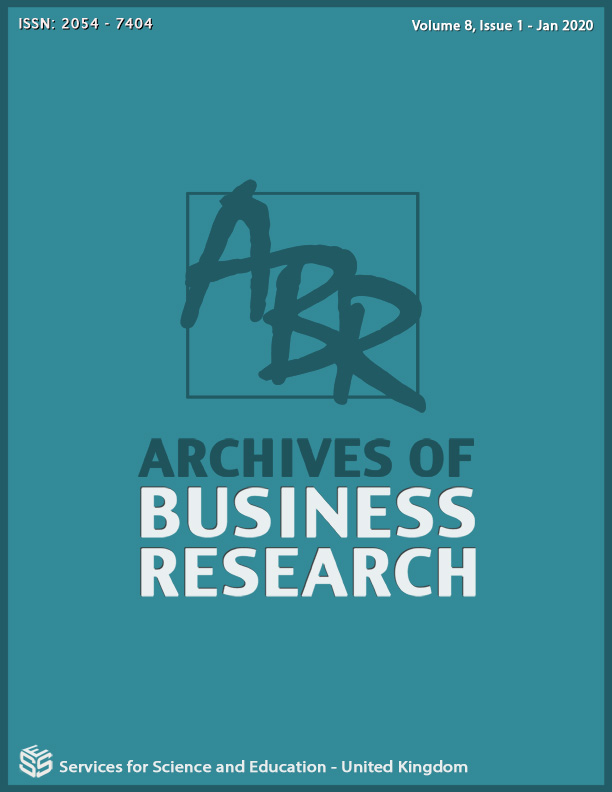Research on the Factors Affecting the Total Factor Productivity of Chinese Life Insurance Companies
DOI:
https://doi.org/10.14738/abr.81.7426Keywords:
Chinese life insurance company; total factor productivity; Malmquist index; analysis of influencing factorsAbstract
Based on the latest method of total factor productivity research at home and abroad, this paper uses the panel data of 17 Chinese life insurance companies from 2007 to 2016 to estimate the total factor productivity of Chinese insurance companies using the Malmquist index analysis method of DEA model. The measurement method is a regression analysis of several factors affecting the total factor productivity of Chinese insurance companies. The empirical results show that among the micro factors, the asset-liability ratio, asset turnover, operating efficiency and company size have a significant impact on the total factor growth rate of Chinese life insurance companies. Among the macro factors, GDP growth rate, inflation rate and unemployment rate have a significant impact on the total factor growth rate of Chinese life insurance companies.
References
[2] Berger, A.N., Mester L.J., 1997. Inside the Black Box: What Explains Differences in the Efficiencies of Financial Institution ?. Journal of Banking and Finance , Vol.21 , pp895-947.
[3] Charnes, A., W.W.Cooper and E. Rhodes, 1978. Measuring the Efficiency of Decision Making Units. European Journal of Operational Research , 429-444.
[4] Cummins, D , M. Weiss, 2000. Analyzing Firm Performance in the Insurance Industry Using Frontier Efficiency Methods, in Georges Dionne (ed.), Handbook of Insurance Economics. Boston: Kluwer Academic Publishers.
[5] Cummins, J., M. Weissand, X. Xie, H.Zi, 2010. Economics of Scope in Financial Services: A DEA Efficiency Analysis of the US Insurance Industry. Journal of Banking and Finance, 34, 1525-1539.
[6] Cui H.X., 2015. Research on Total Factor Productivity of China's Insurance Industry—Based on Comparison between Insurance Group and Independent Insurance Company. Financial Review 1, 100-126.
[7] Fare , Rolf , Shawna Grosskoft, Mary Norris and Zhongyang Zhang, 1994. Productivity Growth, Technical Progress, and Efficiency Change in Industrialized Countries. Economic Review Vol.84(1), 66-83.
[8] Fare, Rolf , Shawna Grosskoft, Mary Norris, 1997. Productivity Growth, Technical Progress, and Efficiency Change in Industrialized Countries: Reply. American Economic Review Vol.87(5):1040-1044.
[9] Farrell, M.J., 1957. The Measurement of Productive Efficiency. Journal of the Royal Statistical Society , Series A (General) Vol.120(3), 253-290.
[10] Huang, W., 2006. An Empirical Study on the Efficiency of Chinese Insurance Institutions Based on SFA Method. Nankai Economic Research 5, 104-115.
[11] Huang, W., 2012. Environment, Risk and Enterprise Technology Efficiency Based on Improved DEA Three-Phase Model. Systems Engineering - Theory & Practice, 1, 1-10.
[12] Malmquist, Stern, 1953. Index Numbers and Indifference Curves. Trabajos de Estatistica 4(1), 209-242.
[13] Segal, D. A., 2003. Multi-Product Cost Study of the U.S. Life Insurance Industry. Review of Quantitative Finance and Accounting, 20:169-186.
[14] Wang, C., Tan, ZH.X., 2007. Research on the Efficiency Structure of China's Commercial Banks. Economic Research 7, 110-123.
[15] Xie, Q., Chen, Y., Jiang. SH.ZH., 2009. A Comparative Analysis of the Impact of Integrated Management on Insurance Business Efficiency - Experience from Europe, America, Japan and Taiwan. Journal of Finance and Economics 1, 62-67.
[16] Yuan X.L., Zhang, B.SH., 2009. Study on the Factors Affecting the Total Factor Productivity of China's Commercial Banks—A Malmquist Index Analysis Based on DEA Model. The Journal of Quantitative and Technical Economics 4, 93-104.
[17] Zheng, L.J., Cao, T.Q., 2005. An Empirical Analysis of the Efficiency of China's Commercial Banks and its Influencing Factors. Financial Research 1, 91-101.






